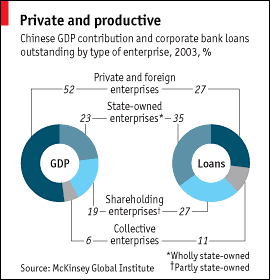|
| ||
|
May 01, 2006
You are on the invidual archive page of If China's banks worked. Click Simon World weblog for the main page.
|
|
If China's banks worked
The Economist looks at how much better off China would be if it's banks worked "properly". By properly, they mean banks that allocated capital and credit by risk rather than political factors, and banks that didn't prop up ailing state firms. Below is a chart that shows the difference between China's GDP by sector and China's bank lending by sector. This mismatch is estimated to have cost China a massive 16% of its GDP...or $320 billion. That's one hell of a mismatch. Full article below the jump. THE Chinese economy continues to astound. Behind its latest surge lies a renewed acceleration of bank lending. Credit growth at the mainland's financial institutions reached 15% in the year to March, just above the official target of 12-14%. Loan volumes are again nearing the levels of the 2003 credit boom, notes Jonathan Anderson, chief Asia economist at UBS. This week the authorities acted to stem the flood.posted by Simon on 05.01.06 at 10:08 AM in the China economy category.
Trackbacks:
TrackBack URL for this entry: http://blog.mu.nu/cgi/trackback.cgi/165840 Send a manual trackback ping to this post.
Comments:
Simon, I saw an article today saying that Chinese NPLs could be around US$900 billion. Give me US$900 billion and I will show you an amazing economic miracle. posted by: HK Dave on 05.03.06 at 03:20 PM [permalink] |
|
